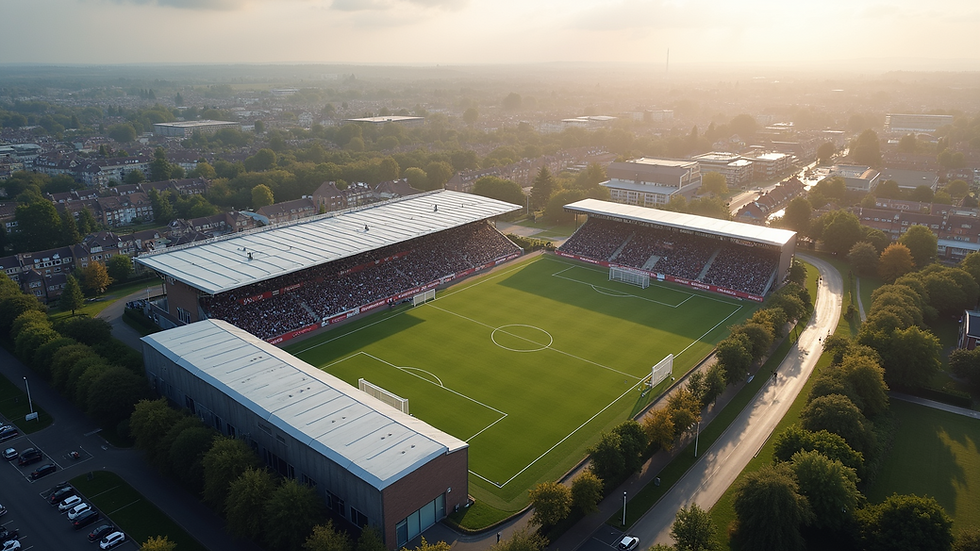Oxford United’s £150m All-Electric Stadium: A New Era for Sustainable Construction
- Michael Ghobrial

- Aug 15
- 4 min read
Oxford United is on the cusp of a transformative journey with the development of a £150 million all-electric stadium. This project marks not just a significant step for the club but also a landmark achievement in sustainable construction. By focusing on green technologies and innovative building practices, Oxford United aims to create a venue that sets a new standard for stadiums in the UK and beyond.
The Vision: Sustainable Construction at Its Core
Sustainability is more than just a buzzword in construction; it’s a necessity. The prototype for Oxford United’s new stadium emphasizes an all-electric design, which eliminates the need for gas-powered systems. This commitment to sustainability will feature a range of energy-efficient technologies, including solar panels and advanced insulation, making the stadium one of the most eco-friendly sports venues in the world.

The concept centers around not only building a structure but crafting a community hub that respects the environment while providing immense benefits to the local population. By prioritizing energy efficiency and reduced carbon footprints, the stadium exemplifies how modern construction can embrace responsible practices.
Key Sustainability Features
The new stadium’s design includes numerous strategies aimed at enhancing sustainability. Let’s explore a few of these noteworthy features:
All-Electric Design
The all-electric nature of the stadium will reduce greenhouse gas emissions significantly, contributing to the fight against climate change. By eliminating fossil fuels from the energy mix, the stadium commits to a greener future. With anticipated energy demands, careful planning in energy distribution will be essential to ensure continuous and efficient supply.
Solar Panels
Incorporating solar panels into the stadium will provide renewable energy that can power day-to-day operations. It’s estimated that the solar installation will help lessen the dependency on the grid, reducing ongoing energy costs and achieving a lower environmental impact.

Energy Efficiency and Climate Control
Through strategic design elements, like advanced insulation and smart climate control systems, the stadium aims to minimize energy consumption while maximizing comfort. These initiatives will significantly contribute to the overall sustainability profile of the stadium.
Water Conservation Systems
Water efficiency is another critical aspect. The integration of rainwater harvesting and greywater recycling will reduce water consumption, making operations efficient and eco-friendly. This not only lessens the strain on local resources but also positions the stadium as a sustainable leader in water management practices.
Construction Process and Timeline: Navigating Challenges
Building the all-electric stadium requires meticulous planning and coordination. The construction process, estimated to be completed in phases over several years, involves collaboration among various stakeholders.
Construction managers face numerous challenges during this ambitious project. From ensuring compliance with new regulations regarding sustainability to managing timelines effectively, every detail must be accounted for. Moreover, procurement officers need to devise strategies that prioritize sourcing green materials and systems.
Procurement Strategies for Green Materials
Securing sustainable materials poses another challenge for project managers. It is vital to develop supplier relationships that support sustainability goals. This might mean looking for local suppliers who can minimize transportation emissions or opting for materials with lower environmental impacts. Strategies could involve:
Conducting thorough market research for green materials.
Implementing vendor evaluation criteria that prioritize sustainability.
Establishing partnerships with companies that specialize in eco-friendly construction solutions.
Furthermore, transparent communication with all stakeholders would ensure that everyone is aligned towards common sustainability goals.

Broader Impact on the Oxford Community
The new stadium promises to deliver a wealth of benefits to the Oxford community, extending far beyond the sports arena.
Job Creation and Economic Benefits
First and foremost, the construction and operation of the stadium will generate numerous jobs, providing employment opportunities for local residents. Skilled labor is essential for building modern, sustainable structures. The project is expected to create an estimated 1,000 direct jobs during construction and more indirectly as it leads to growth in surrounding industries.
Boosting Local Tourism
Additionally, the stadium is set to attract increased tourism to the area. The anticipation surrounding the launch of an all-electric facility will likely draw visitors interested in sustainable practices and cutting-edge architectural design. Local businesses, including hotels and restaurants, could see a marked improvement in patronage, contributing to a vibrant community economy.
Improved Transport Links
Plans for the stadium also include enhancements to local transport links. Improved public transport options, along with pedestrian pathways, will make access easier while encouraging more sustainable travel methods. Investing in infrastructure that prioritizes public transportation could set precedents for other projects in the UK.
Lessons for Future Sustainable Stadium Projects in the UK and Middle East
As Oxford United moves forward with this groundbreaking project, invaluable lessons can be drawn for future stadium developments, particularly in the UK and Middle East where sustainability is becoming increasingly important.
Collaboration is Key: Multi-disciplinary teamwork among architects, engineers, and sustainability experts leads to innovative solutions.
Embrace Local Materials: Using local resources can reduce carbon footprints associated with transport and support regional economies.
Plan for the Long-Term: Development must focus not just on the initial construction phase but also on long-term sustainability strategies, including maintenance and energy use.
Engage the Community: Involving local stakeholders in the planning and execution process ensures that the project supports community needs and wishes.
Innovate and Educate: Stadiums should serve as educational platforms, showcasing sustainable technologies and practices to inspire future initiatives.
In conclusion, the £150 million all-electric stadium represents a significant leap forward for both Oxford United and sustainable construction at large. By focusing on innovative technologies and community engagement, the project is set to become a hallmark of modern stadium design and a model for future developments across the UK and Middle East. The lessons learned from this venture will resonate, paving the way for greener, more inclusive construction practices for years to come.









